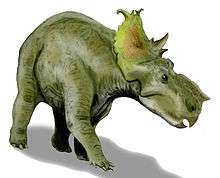Wapiti Formation
The Wapiti Formation is a geological formation of the Western Canada Sedimentary Basin in northwestern Alberta, and Northeastern British Columbia, Canada. Its deposition spanned the time interval from Late Cretaceous (Campanian stage) to early Paleocene, and it includes sediments that were deposited before, during, and after the Cretaceous-Paleogene (K-Pg) extinction event.[2] It was named by G.M. Dawson in 1881,[1] presumably for exposures along the lower part of the Wapiti River and downstream along the Smoky River in Alberta.[3]
| Wapiti Formation Stratigraphic range: Late Cretaceous to Early Paleocene | |
|---|---|
| Type | Geological formation |
| Lithology | |
| Primary | Sandstone, siltstone, mudstone |
| Other | conglomerate, coal |
| Location | |
| Region | |
| Country | |
| Type section | |
| Named for | Lower part of Wapiti River |
| Named by | G.M. Dawson, 1881.[1] |
Dinosaur remains are among the fossils that have been recovered from the Cretaceous portion of the formation.[4] The Wapiti Formation does not produce many fossils due to its limited surface exposure and accessibility, although two Pachyrhinosaurus bone beds have been productive.[5]
Lithology
The Wapiti Formation consists of interbedded sandstones, siltstones, shales and mudstones, with thin conglomerates, coal seams and bentonite beds. The sandstones are typically thick, pale grey, crossbedded and bentonitic. The middle part contains less sandstones, more mudstones, and fewer and thinner coals. The upper part contains thicker lenticular sandstones and more coals.[3]
Depositional environment
The Wapiti Formation was deposited in inland fluvial and floodplain environments, with local areas of lacustrine sediments.[2] The sandstones were deposited mainly in fluvial channel environments, with siltstones, carbonaceous shales and coals accumulating in overbank settings.
Thickness and Distribution
The Wapiti Formation rests conformably on the marine shales of the Smoky Group. It is more than 1,300 m (4,300 ft) thick in the foothills of the Canadian Rockies in the west,[2] and it thins eastward to its erosional edge.[6] It is correlative with the entire sequence of the Belly River Group, Bearpaw Formation, Edmonton Group and Scollard Formation in south-central Alberta.[2] In most areas it is unconformably overlain by glacial and post-glacial sediments of Quaternary age, or exposed at surface. In a few upland areas it is unconformably overlain by Paleogene gravel deposits.[3]
Vertebrate paleofauna
Color key
|
Notes Uncertain or tentative taxa are in small text; |
| Dinosaurs of the Wapiti Formation | ||||||
|---|---|---|---|---|---|---|
| Genus | Species | Location | Member | Material | Notes | Images |
|
Indeterminate |
|
|||||
|
Indeterminate |
|
|||||
|
B. fredlundi |
|
|
Three trackways and an isolated print. |
Footprints of large tyrannosaurids. |
||
|
B. certekorum |
|
|
 Boreonykus certekorum | |||
|
E. regalis |
|
|
| |||
|
Indeterminate |
|
|||||
|
Indeterminate |
|
|||||
|
P. lakustai |
|
 Pachyrhinosaurus lakustai | ||||
|
R. gilmorei |
|
|||||
|
Indeterminate |
|
|||||
|
S. sp. |
|
|||||
See also
- List of dinosaur-bearing rock formations
References
- Dawson, G.M. 1881. Report on the exploration from Simpson on the Pacific coast to Edmonton on the Saskatchewan River, embracing a portion of the northern part of Brisish Columbia and the Peace River country. Geological Survey of Canada, Report of Progress 1879-1880, Part B, p. 1-77.
- Mossop, G.D. and Shetsen, I., (compilers), Canadian Society of Petroleum Geologists (1994). "The Geological Atlas of the Western Canada Sedimentary Basin, Chapter 24: Upper Cretaceous and Tertiary strata of the Western Canada Sedimentary Basin". Retrieved 2013-08-01.CS1 maint: multiple names: authors list (link)
- Glass, D.J. (editor) 1997. Lexicon of Canadian Stratigraphy, vol. 4, Western Canada including eastern British Columbia, Alberta, Saskatchewan and southern Manitoba. Canadian Society of Petroleum Geologists, Calgary, 1423 p. on CD-ROM. ISBN 0-920230-23-7.
- Weishampel, David B; et al. (2004). "Dinosaur distribution (Late Cretaceous, North America)." In: Weishampel, David B.; Dodson, Peter; and Osmólska, Halszka (eds.): The Dinosauria, 2nd, Berkeley: University of California Press. Pp. 574-588. ISBN 0-520-24209-2.
- Ryan, M. J., and A. P. Russell, 2001, Dinosaurs of Alberta (exclusive of Aves), in: Mesozoic Vertebrate Life, edited by Tanke, D. H., and K. Carpenter, Indiana University Press, pp. 279–297 ISBN 978-0253339072
- Prior, G. J., Hathaway, B., Glombick, P.M., Pana, D.I., Banks, C.J., Hay, D.C., Schneider, C.L., Grobe, M., Elgr, R., and Weiss, J.A. (2013). "Bedrock Geology of Alberta. Alberta Geological Survey, Map 600". Retrieved 2013-08-13.CS1 maint: multiple names: authors list (link)
- Currie, P.J., Langston, W., and Tanke, D.H. (2008). "A new species of Pachyrhinosaurus (Dinosauria, Ceratopsidae) from the Upper Cretaceous of Alberta, Canada." pp. 1-108. In: Currie, P.J., Langston, W., and Tanke, D.H. 2008. A New Horned Dinosaur from an Upper Cretaceous Bone Bed in Alberta. NRC Research Press, Ottawa, Ontario, Canada. 144 pp. ISBN 978-0-660-19819-4
- F. Fanti and T. Miyashita. 2009. A high latitude vertebrate fossil assemblage from the Late Cretaceous of west-central Alberta, Canada: evidence for dinosaur nesting and vertebrate latitudinal gradient. Palaeogeography, Palaeoclimatology, Palaeoecology 275(1-4):37-53
- Bell, P. R., and P. J. Currie. 2015. A high-latitude dromaeosaurid, Boreonykus certekorum, gen. et sp. nov. (Theropoda), from the upper Campanian Wapiti Formation, west-central Alberta. Journal of Vertebrate Paleontology. DOI: 10.1080/02724634.2015.1034359. http://www.tandfonline.com/doi/full/10.1080/02724634.2015.1034359
- P. R. Bell, F. Fanti, J. Acorn and R. S. Sissons. 2013. Fossil mayfly larvae (Ephemeroptera, cf. Heptageniidae) from the Late Cretaceous Wapiti Formation, Alberta, Canada. Journal of Paleontology 87:147-150
